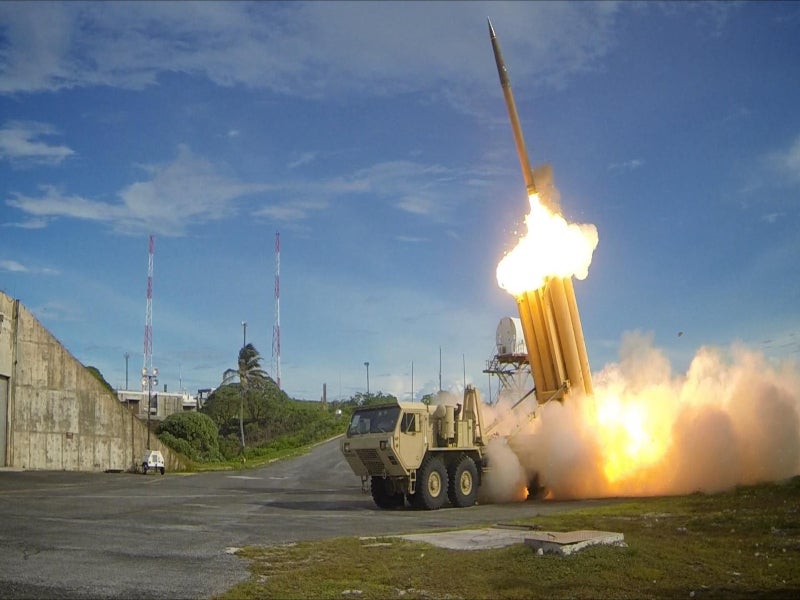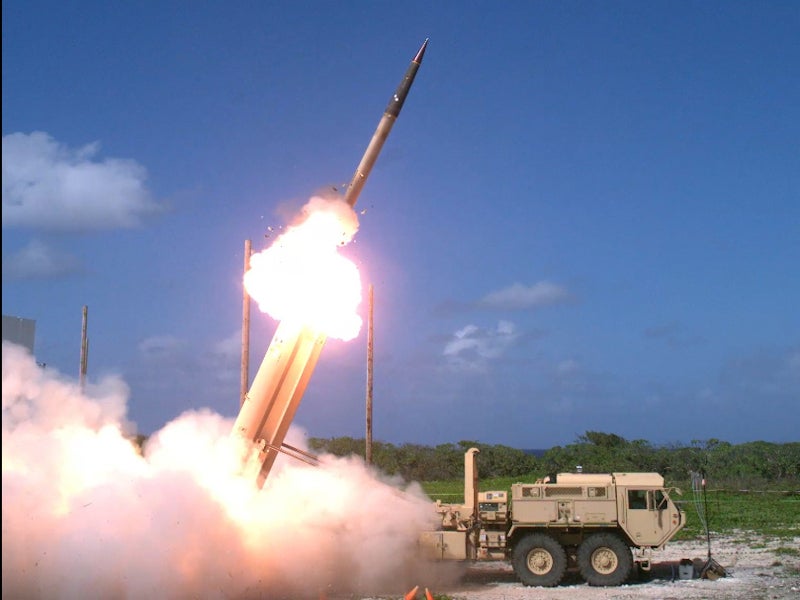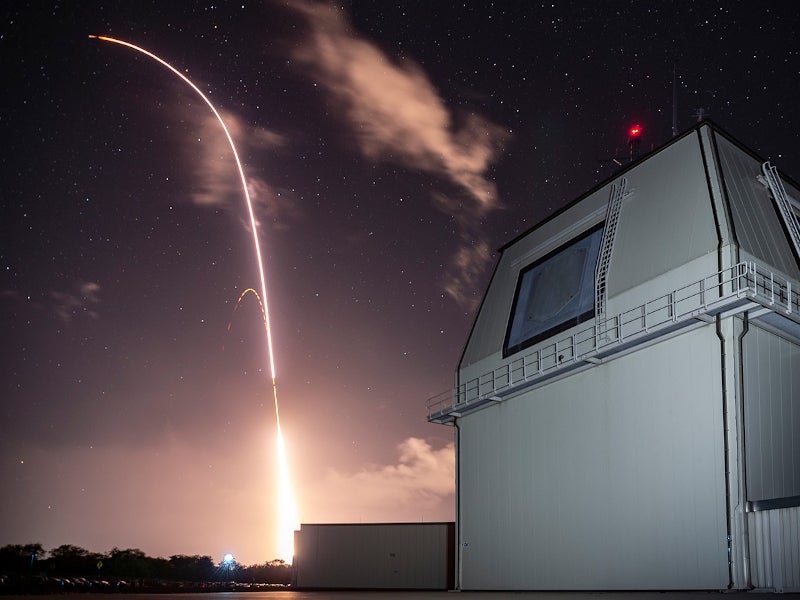The THAAD terminal (formerly theatre) high-altitude area defence missile system is an easily transportable defensive weapon system to protect against hostile incoming threats, such as tactical and theatre ballistic missiles, at ranges of 200km and altitudes of up to 150km.
THAAD system provides the upper tier of a ‘layered defensive shield’ to protect high-value strategic or tactical sites such as airfields or populations centres. The THAAD missile intercepts exo-atmospheric and endo-atmospheric threats.
The sites would also be protected with lower and medium-tier defensive shield systems, such as the Patriot PAC-3, which intercepts hostile incoming missiles at 20 to 100 times lower altitudes.
THAAD system has maintained a 100% success rate over its last 16 intercept tests since the beginning of production. The system used a government-developed remote launcher kit in its 16th attempt in August 2019, for the first time, to extend the range of the defended area.
THAAD air defence missile programme
The US Army is expected to acquire 80 to 99 THAAD launchers, 18 ground-based radars and a total of 1,422 THAAD missiles. Two THAAD battalions are planned, each with four batteries.
In 1992, Lockheed Martin Missiles and Space and other industrial team partners were awarded a $689m contract to develop the THAAD system. Raytheon was selected as sub-contractor to develop the ground-based radar.
Raytheon is responsible for the solid-state receiver / transmitter modules, while TRW is responsible for software development. The other main contractors are Raytheon for the travelling wave tubes, Datatape for the data recorders, and EBCO for radar turrets.
The THAAD programme entered the engineering and manufacturing development (EMD) phase in 2000. In May 2004, production of 16 flight test missiles began at Lockheed Martin’s new production facilities in Pike County, Alabama.
Flight testing, at White Sands Missile Range, New Mexico, of the EMD system began in 2005. The first flight test of the entire system, including missile, launcher, radar and fire control system, took place in May 2006. Flight testing began at Pacific Missile Range, Kauai, Hawaii in January 2007, with a successful intercept test in the high endo-atmosphere.
A second successful test took place in April 2007, with intercept in the mid endo-atmosphere. The final White Sands test took place in June 2007, with a low endo-atmosphere test. In October 2007, THAAD performed a successful intercept of a unitary target outside the atmosphere (exo-atmospheric). In June 2008, THAAD successfully intercepted a separating target in mid-endo-atmosphere. Until the end of 2011, THAAD has completed nine intercepts and 12 flight tests.
In January 2007, Lockheed Martin was awarded a contract for the first two production THAAD systems to include six launchers, 48 missiles, two radars and two tactical operations centres. The first THAAD weapon system launcher, and fire control and communications unit, were launched in April 2009.
In May 2008, the US Army activated the first THAAD battery unit at Fort Bliss, Texas. In August 2007, Lockheed Martin announced that THAAD launcher, fire control and communications units were built at its Camden, Arkansas facility. The THAAD interceptor was built at its Pike County facility in Troy, Alabama. The second battery unit was activated in October 2009.
In September 2008, the United Arab Emirates requested the sale of three THAAD fire units, 147 missiles, four THAAD radars, six fire control stations and nine launchers. In 2011, UAE signed a $1.96bn deal for two THAAD weapon systems and the support equipment. This is the first foreign military sale of THAAD.
The US Army contract for the third and fourth THAAD battery units was awarded to Lockheed Martin in 2010 and 2011. The contract for the fifth battery was awarded in late 2012.
A $66m follow-on contract was awarded to Lockheed Martin for continued development of the THAAD system, in March 2012. The company was awarded a $150m contract for 12 launchers, two fire control and communications units, and associated support equipment in August 2012.
The THAAD missile system successfully engaged a medium-range ballistic missile during an integrated ballistic missile defence system test conducted in October 2012. Another missile defence flight test was conducted in September 2013.
Lockheed Martin was awarded a $3.9bn contract for the manufacture and delivery of up to 110 interceptors for the US Army in September 2013. The contractual scope also includes production of interceptors and other ground hardware for the UAE.
The THAAD laser-initiated ordnance system is being developed by Pacific Scientific Energetic Materials Company (PSEMC). Alfalight was awarded a $3.7m contract by PSEMC for the delivery of lasers in September 2014.
The missile defense agency (MDA) placed a $124.6m order with Lockheed for the supply of THAAD ground components, in October 2014.
Lockheed achieved the milestone of delivering 100 interceptors to the US and its allied nations in July 2015.
Lockheed Martin received a $528m contract from the MDA for the supply of THAAD missile system interceptors, in January 2016.
In January 2017, Lockheed secured a $459m order from the MDA for the development of THAAD interceptors.
THAAD system’s (FTT-23) remote launching capability was tested by the US Missile Defense Agency to destroy ballistic missile threats in August 2019. It successfully detected, tracked and intercepted a medium-range ballistic missile (MRBM) target during the test.
THAAD programme is supported by more than 280 suppliers across 40 states of the US, creating approximately 18,000 jobs in the country.
THAAD missile battery
The THAAD battery typically operates nine launch vehicles each carrying eight missiles, with two mobile tactical operations centres (TOCs) and a ground-based radar (GBR).
THAAD missile information
The target object data and the predicted intercept point are downloaded to the missile prior to launch. The updated target and intercept data are also transmitted to the missile in flight.
The missile is 6.17m in length and is equipped with a single stage solid fuel rocket motor with thrust vectoring. The rocket motor is supplied by Pratt & Whitney Rocketdyne. The launch weight is 900kg.
A separation motor is installed at the interstage at the forward end of the booster section. The separation motor assists in the separation of the kinetic kill vehicle (KKV) and the spent boost motor.
Aerojet Rocketdyne delivered 600th Boost Motor and the Divert and Attitude Control System (DACS) for the THAAD system in June 2020.
The shroud separates from the KV before impact. The KV is equipped with a liquid-fuelled divert and attitude control system (DACS), developed by Pratt & Whitney Rocketdyne, for the terminal manoeuvring towards the target intercept point.
A gimbal-mounted infrared seeker module in the nose section provides terminal homing to close in on the target missile in the terminal phase of approach.
During the initial fly-out phase of flight, the seeker window is covered with a two-piece clamshell protection shroud. Metal bladders installed in the shroud are inflated to eject the protective shroud before the seeker initiates target acquisition. The infrared seeker head, developed by BAe Systems, is an indium antimonide (InSb) staring focal plane array operating in the mid-infrared 3μm to 5μm wavelength band.
M1075 truck-mounted launcher
There are nine M1075 truck-mounted launchers in a typical THAAD battery. Launch vehicle is a modified Oshkosh Truck Corporation heavy expanded mobility tactical truck with load-handling system (HEMTT-LHS). The 12m-long by 3.25m-wide launch vehicle carries ten missile launch containers. While on the launcher, lead acid batteries provide the primary power. The batteries are recharged with a low-noise generator.
After firing, reloading the launch vehicle takes 30 minutes.
Ground-based radar
The cueing for the THAAD system is provided by the Raytheon Systems AN/TPY-2 ground-based radar (GBR) for surveillance, threat classification and threat identification. THAAD can also be cued by military surveillance satellites such as Brilliant Eyes.
The ground-based radar units are C-130 air transportable. The AN/TPY-2 radar uses a 9.2m² aperture full field of view antenna phased array operating at I and J bands (X band) and containing 25,344 solid-state microwave transmit and receive modules. The radar has the capability to acquire missile threats at ranges of up to 1,000km.
The first production radar was tested at the White Sands Missile Range in New Mexico. In September 2004, the THAAD radar tracked a tactical ballistic missile, cueing a successful intercept by a Patriot PAC-3 missile. A second radar was delivered to White Sands in June 2007.
The US Missile Defence Agency awarded a $2.3bn production contract to Raytheon for seven gallium nitride (GaN)-based AN/TPY-2 radars as a THAAD system component in June 2020.
Tactical operations centre
Each THAAD battery has two tactical operations centres (TOC). The TOC has been developed by Northrop Grumman, formerly Litton Data Systems Division. The TOC accommodates two operator stations and is equipped with three Hewlett-Packard HP-735 data processors.
Mobile BMC3I units
The THAAD system is able to ‘hand over’ targets to other defence systems and can cue the targets to other weapons. THAAD is able to interface to other US or allied air defence data information networks and to the battle management and command control and communications centre.
Northrop Grumman has been contracted to develop the THAAD BMC3I. The battle management and command, control, computers and intelligence (BMC3I) units are installed in hardened shelters mounted on high-mobility multi-wheeled vehicles (HMMWVs).
The THAAD communications system can use a joint tactical information distribution system (JTIDS), mobile subscriber equipment, a single channel ground and airborne radio system (SINCGARS) and the joint tactical terminal for voice and data communications and for intelligence data transfer.





